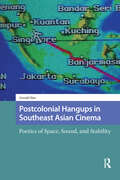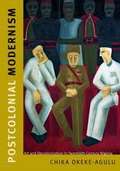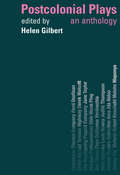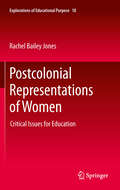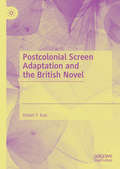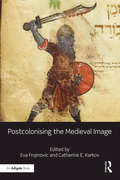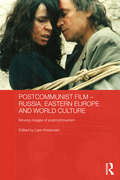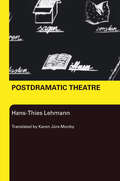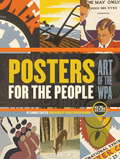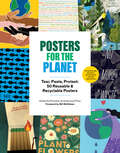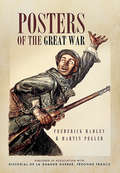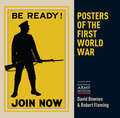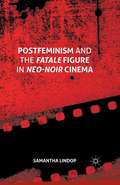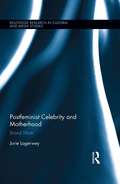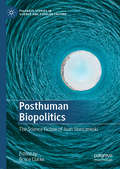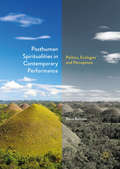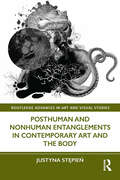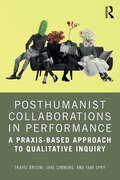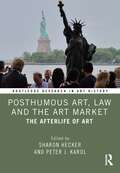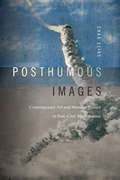- Table View
- List View
Postcolonial Hangups in Southeast Asian Cinema: Poetics of Space, Sound, and Stability (Critical Asian Cinemas)
by Gerald SimPostcolonial Hangups in Southeast Asian Cinema: Poetics of Space, Sound, and Stability rethinks theory and style through films that bring the limits of traditional postcolonial frameworks into stark relief. Discover Singapore's preoccupations with space, Yasmin Ahmad's Malaysian soundscapes, and Indonesia's investment in genre. These undertheorized films from geopolitically situated cultures narrate colonial identity within a distinctively Southeast Asian story. Gerald Sim's immersive journey nurtures connections between narrative film, commercial video, art cinema, and experimental work with an abiding commitment to self-reflexive theorizing. The book culminates in a reflection on the ethics and politics of conducting knowledge work on world cinema. Sim navigates Singapore's love of maps with the work of Tom Conley and Gilles Deleuze, surveys the city-state's cartographic uncanny, before using the spatial inquisitions in filmmaker Tan Pin Pin's cinema of hiraeth to appreciate Singapore's territorial predispositions. The book then revisits a beloved Malaysian director's voice of modernity alongside Jean-Luc Nancy's phenomenologies of listening and globalization. Original readings of Ahmad's oeuvre dwell on the interplay between her ethnic cacophonies and imperfect subtitling. Finally, Sim focuses on the postcoloniality of Indonesia's Cold War alliance with the United States to contemplate the overhang of authoritarian stability within its contemporary cinema's generic recourse.
Postcolonial Modernism: Art and Decolonization in Twentieth-Century Nigeria
by Chika Okeke-AguluWritten by one of the foremost scholars of African art and featuring 129 color images, Postcolonial Modernism chronicles the emergence of artistic modernism in Nigeria in the heady years surrounding political independence in 1960, before the outbreak of civil war in 1967. Chika Okeke-Agulu traces the artistic, intellectual, and critical networks in several Nigerian cities. Zaria is particularly important, because it was there, at the Nigerian College of Arts, Science and Technology, that a group of students formed the Art Society and inaugurated postcolonial modernism in Nigeria. <p><p> As Okeke-Agulu explains, their works show both a deep connection with local artistic traditions and the stylistic sophistication that we have come to associate with twentieth-century modernist practices. He explores how these young Nigerian artists were inspired by the rhetoric and ideologies of decolonization and nationalism in the early- and mid-twentieth century and, later, by advocates of negritude and pan-Africanism. They translated the experiences of decolonization into a distinctive "postcolonial modernism" that has continued to inform the work of major Nigerian artists.
Postcolonial Plays: An Anthology
by Helen GilbertThis collection of contemporary postcolonial plays demonstrates the extraordinary vitality of a body of work that is currently influencing the shape of contemporary world theatre. This anthology encompasses both internationally admired 'classics' and previously unpublished texts, all dealing with imperialism and its aftermath. It includes work from Canada, the Carribean, South and West Africa, Southeast Asia, India, New Zealand and Australia. A general introduction outlines major themes in postcolonial plays. Introductions to individual plays include information on authors as well as overviews of cultural contexts, major ideas and performance history.Dramaturgical techniques in the plays draw on Western theatre as well as local performance traditions and include agit-prop dialogue, musical routines, storytelling, ritual incantation, epic narration, dance, multimedia presentation and puppetry. The plays dramatize diverse issues, such as:*globalization* political corruption* race and class relations*slavery*gender and sexuality*media representation*nationalism
Postcolonial Representations of Women: Critical Issues for Education
by Rachel Bailey JonesIn this accessible combination of post-colonial theory, feminism and pedagogy, the author advocates using subversive and contemporary artistic representations of women to remodel traditional stereotypes in education. It is in this key sector that values and norms are molded and prejudice kept at bay, yet the legacy of colonialism continues to pervade official education received in classrooms as well as 'unofficial' education ingested via popular culture and the media. The result is a variety of distorted images of women and gender in which women appear as two-dimensional stereotypes. The text analyzes both current and historical colonial representations of women in a pedagogical context. In doing so, it seeks to recast our conception of what 'difference' is, challenging historical, patriarchal gender relations with their stereotypical representations that continue to marginalize minority populations in the first world and billions of women elsewhere. These distorted images, the book argues, can be subverted using the semiology provided by postcolonialism and transnational feminism and the work of contemporary artists who rethink and recontextualize the visual codes of colonialism. These resistive images, created by women who challenge and subvert patriarchal modes of representation, can be used to create educational environments that provide an alternative view of women of non-western origin.
Postcolonial Screen Adaptation and the British Novel
by Vivian Y. KaoThis book brings film adaptation of literature to bear on the question of how nineteenth-century imperial ideologies of progress continue to inform power inequalities in a global capitalist age. Not simply the promotion of general betterment for all, improvement in the British colonial context licensed a superior “master race” to “uplift” its colonized populations—morally, socially, and economically. This book argues that, on the one hand, film adaptations of nineteenth-century novels reveal the arrogance and coercive intentions that underpin contemporary notions of development, humanitarianism, and modernity—improvement’s post-Victorian guises. On the other hand, the book also argues that the films use their nineteenth-century source texts to criticize these same legacies of imperialism. By bringing together film adaptation, postcolonial theory, and literary studies, the book demonstrates that adaptation, as both method and cultural product, provides a way to engage with the baggage of ideological heritage in our contemporary global media environment.
Postcolonialism, Heritage, and the Built Environment: New Approaches to Architecture in Archaeology (SpringerBriefs in Archaeology)
by Jessica L. Nitschke Marta LorenzonThis book proposes new ways of looking at the built environment in archaeology, specifically through postcolonial perspectives. It brings together scholars and professionals from the fields of archaeology, urban studies, architectural history, and heritage in order to offer fresh perspectives on extracting and interpreting social and cultural information from architecture and monuments. The goal is to show how on-going critical engagement with the postcolonial critique can help archaeologists pursue more inclusive, sensitive, and nuanced interpretations of the built environment of the past and contribute to heritage discussions in the present. The chapters present case studies from Africa, Greece, Belgium, Australia, Syria, Kuala Lumpur, South Africa, and Chile, covering a wide range of chronological periods and settings. Through these diverse case studies, this volume encourages the reader to rethink the analytical frameworks and methods traditionally employed in the investigation of built spaces of the past. To the extent that these built spaces continue to shape identities and social relationships today, the book also encourages the reader to reflect critically on archaeologists’ ability to impact stakeholder communities and shape public perceptions of the past.
Postcolonising the Medieval Image
by Eva Frojmovic Catherine E. KarkovPostcolonial theories have transformed literary, historical and cultural studies over the past three decades. Yet the study of medieval art and visualities has, in general, remained Eurocentric in its canon and conservative in its approaches. 'Postcolonising', as the eleven essays in this volume show, entails active intervention into the field of medieval art history and visual studies through a theoretical reframing of research. This approach poses and elicits new research questions, and tests how concepts current in postcolonial studies - such as diaspora and migration, under-represented artistic cultures, accented art making, displacement, intercultural versus transcultural, hybridity, presence/absence - can help medievalists to reinvigorate the study of art and visuality. Postcolonial concepts are deployed in order to redraft the canon of medieval art, thereby seeking to build bridges between medievalist and modernist communities of scholars. Among the varied topics explored in the volume are the appropriation of Roman iconography by early medieval Scandinavian metalworkers, multilingualism and materiality in Anglo-Saxon culture, the circulation and display of Islamic secular ceramics on Pisan churches, cultural negotiation by Jewish minorities in Central Europe and the Iberian peninsula, Holy Land maps and medieval imaginative geography, and the uses of Thomas Becket in the colonial imaginary of the Plantagenet court.
Postcommunist Film - Russia, Eastern Europe and World Culture: Moving Images of Postcommunism (Routledge Contemporary Russia and Eastern Europe Series)
by Lars KristensenA post-communist condition has arisen from the fall of the Berlin Wall and later the Soviet Empire: this book looks at how this condition has manifested itself globally in the production of post-communist film. It argues post-communism is a shared experience on a geopolitical level, unlimited by national state borders, and examines post-communist cross culturalism and global totalitarianism within film. The book examines different national cinemas and dissimilar cinematic modes - from Russian blockbuster cinema to Chinese independent cinema; from Serbian city films to revolutionary films of Mozambique - all formulated as within the postcommunist condition. It considers the postcommunist film in terms of transnational and World cinema. It covers a wide range of films from small and independent filmmaking to mainstream, popular cinema, and explains post-communist signifiers as manifested in visual culture both inside and outside former, and current, communist countries.
Postdramatic Theatre
by Hans-Thies LehmannNewly adapted for the Anglophone reader, this is an excellent translation of Hans-Thies Lehmann’s groundbreaking study of the new theatre forms that have developed since the late 1960s, which has become a key reference point in international discussions of contemporary theatre. In looking at the developments since the late 1960s, Lehmann considers them in relation to dramatic theory and theatre history, as an inventive response to the emergence of new technologies, and as an historical shift from a text-based culture to a new media age of image and sound. Engaging with theoreticians of 'drama' from Aristotle and Brecht, to Barthes and Schechner, the book analyzes the work of recent experimental theatre practitioners such as Robert Wilson, Tadeusz Kantor, Heiner Müller, the Wooster Group, Needcompany and Societas Raffaello Sanzio. Illustrated by a wealth of practical examples, and with an introduction by Karen Jürs-Munby providing useful theoretical and artistic contexts for the book, Postdramatic Theatre is an historical survey expertly combined with a unique theoretical approach which guides the reader through this new theatre landscape.
Posted to Canada: The Watercolours of George Russell Dartnell, 1835-1844
by Honor De PencierPosted to Canada examines, for the first time, the immense body of work created by George Dartnell, a British army surgeon stationed in Canada from 1835 to 1844. Dartnell, an accomplished and popular surgeon, sketched more than 150 scenes of a pristine Canada of dense forests, clear lakes and rough-edged beauty during his nine-year posting – all of which form an important part of Canada’s pre-photographic visual history. In this, the first book on Dartnell, his vibrant depictions of rural Quebec and Ontario, Montreal, Quebec City, Penetanguishene, London, and Port Talbot are examined in great detail. Dartnell’s work offers rare and insightful glimpses of both the life of a surgeon in the early nineteenth century and the fledgling communities in which he served. among the rare scenes portrayed by Dartnell lare the first known depictions of St. Marys, Ontario, and maple-sugaring near Penetanguishene. Of the dozens of sketches reproduced in the book, many have been culled from private collections and never before displayed publicly.
Posters for the People: Art of the WPA
by Ennis CarterThis lavishly illustrated volume amasses nearly 500 of the best and most striking posters designed by artists working in the 1930s and early 1940s for the government-sponsored Works Progress Administration, or WPA. Posters for the People presents these works for what they truly are: highly accomplished and powerful examples of American art. All are iconic and eye-catching, some are humorous and educational, and many combine modern art trends with commercial techniques of advertising. More than 100 posters have never been published or catalogued in federal records; they are included here to ensure their place in the history of American art and graphic design. The story of these posters is a fascinating journey, capturing the complex objectives of President Franklin Roosevelt’s New Deal reform program. Through their distinct imagery and clear and simple messages, the WPA posters provide a snapshot of an important era when the U.S. government employed hundreds of artists to create millions of posters promoting positive social ideals and programs and a uniquely American way of life. The resulting artworks now form a significant historical record. More than a mere conveyor of government information, they stand as timeless images of beauty and artistic accomplishment.
Posters for the Planet: Tear, Paste, Protest: 50 Reusable and Recyclable Posters
by Princeton Architectural PressThese 50 full-color tear-out posters feature original artwork that conveys the urgent need to take action to combat climate change. Whether you're an activist, a student, or are looking for the perfect environmental gift, this collection of original posters from a series of international artists and designers is sure to inspire change. In a time when our environmental future is uncertain, natural disasters are becoming more frequent, and the window to avoid further irreversible climate damage is closing, collective action is essential. Compiled from an open call (design poured in from all over the world), 50 winning designs were selected from more than 800 entries. A global problem requires a global solution. Historically, posters have been one of the most common mediums of communication for dissent and social change, and the 50 tear-out posters in Posters for the Planet allow you to voice the importance of taking action now. Printed on 11-by-17-inch FSC paper, each of the perforated posters features a unique design that you can proudly display or distribute to convey how crucial it is to act responsibly, fight climate change through environmental policy, and create a bright future for ourselves and future generations. Partial proceeds of the sale of this book will be donated to Indigenous Environmental Network, Clean Air Task Force, and Coalition for Rainforest Nations.
Posters of The Great War: Published in Association with Historical le Grande Guerre, Peronne, France
by Martin Pegler Frédérick HadleyUntil the arrival of radio and television, and despite the influence of newspapers, posters were the major medium for mass communication. During the Great War all the belligerent nations produced an extraordinary variety of them - and they did so on a massive scale. As the 200 wartime and immediate post-war posters selected for this book reveal, they were one of the most potent, and memorable, ways of conveying news, information and propaganda. In the most graphic and colourful fashion they promoted values such as patriotism and sacrifice. By using rallying symbols such as flags as well as historical and mythical models, they sought to maintain morale and draw people together by stirring up anger against the enemy. Today their remarkable variety of styles give us an instant insight into the themes and messages the military and civilian authorities wished to publicize.The sheer inventiveness of the poster artists is demonstrated as they focused on key aspects of the propaganda campaign in Britain, France, Germany, America and Russia. The diversity of their work is displayed here in chapters that cover recruitment, money raising, the soldier, the enemy, the family and the home front, films and the post-war world. A century ago, when these images were first viewed, they must have been even more striking in contrast to the poor-quality newspaper photographs and postcards that were available at the time. The Great War was to change that forever. It introduced a means of propaganda that was novel, persuasive and above all, powerful. It was the first media war, and the poster played a key role in it.
Posters of the First World War
by Robert FlemingThe First World War, a new low in the annals of armed conflict, coincided with a golden age for the relatively new art of advertising. Striking and colourful posters were produced throughout the years 1914-18 to recruit soldiers, promote investment, keep up morale and, naturally, to vilify the enemy; prominent artists including Alfred Leete paired bold images with punchy text to maximise impact. The selection in this book offers an informative guide to the range of posters created and to how they were displayed around the nation, and explores the public's increasing dissatisfaction with being patronised and goaded. From the iconic, commanding Your Country Needs YOU! to the anxious domestic scene of Daddy, What Did YOU Do in the War?, and including the infamous depiction of a bayoneting in Back Him Up!, this book puts the reader in the shoes of the Great War 'man in the street'.
Postfeminism and the Fatale Figure in Neo-Noir Cinema
by Samantha LindopThis book is a thought-provoking study that expands on film scholarship on noir and feminist scholarship on postfeminism, subjectivity, and representation to provide an inclusive, sophisticated, and up-to-date analysis of the femme fatale , fille fatale , and homme fatal from the classic era through to recent postmillennial neo-noir .
Postfeminist Celebrity and Motherhood: Brand Mom (Routledge Research in Cultural and Media Studies)
by Jorie LagerweyThis book analyzes the intersections of celebrity, self-branding, and "mommy" culture. It examines how images of celebrity moms playing versions of themselves on reality television, social media, gossip sites, and self-branded retail outlets negotiate the complex demands of postfeminism and the current fashion for heroic, labor intensive parenting. The cultural regime of "new momism" insists that women be expert in both affective and economic labor, producing loving families, self-brands based on emotional connections with consumers, and lucrative saleable commodities. Successfully creating all three: a self-brand, a style of motherhood, and lucrative product sales, is represented as the only path to fulfilled adult womanhood and citizenship. The book interrogates the classed and racialized privilege inherent in those success stories and looks for ways that the versions of branded motherhood represented as failures might open a space for a more inclusive emergent feminism.
Posthuman Biopolitics: The Science Fiction of Joan Slonczewski (Palgrave Studies in Science and Popular Culture)
by Bruce ClarkeThis volume presents the first collection of essays dedicated to the science fiction of microbiologist Joan Slonczewski. Posthuman Biopolitics consolidates the scholarly literature on Slonczewski’s fiction and demonstrates fruitful lines of engagement for the critical, cultural, and theoretical treatment of her characters, plots, and storyworlds. Her novels treat feminism in relation to scientific practice, resistance to domination, pacifism versus militarism, the extension of human rights to nonhuman and posthuman actors, biopolitics and posthuman ethics, and symbiosis and communication across planetary scales. Posthuman Biopolitics explores the breadth and depth of Joan Slonczewski’s vision, uncovering the reflective ethical practice that informs her science fiction.
Posthuman Pedagogies in Practice: Arts based Approaches for Developing Participatory Futures
by Annouchka BayleyThis book investigates transdisciplinary, arts-based approaches to developing innovative and pertinent higher education pedagogy. Introducing timely critical thinking strategies, the author addresses some of the key issues facing educators today in an increasingly complex digital, technological and ecological world. The author combines emerging ideas in the New Materialism and Posthumanism schools of thought with arts-based teaching and learning, including Practice-as-Research, for Social Science contexts, thus exploring how this approach can be used to productively create new pedagogical strategies. Drawing on a rich repertoire of real-life examples, the volume suggests transferrable routes into practice that are suitable for lecturers, researchers and students. This practical and innovative volume will appeal to researchers and practitioners interested in Posthuman and New Materialist theories, and how these can be applied to the educational landscape in future.
Posthuman Spiritualities in Contemporary Performance: Politics, Ecologies and Perceptions
by Silvia BattistaThis book provides an interpretative analysis of the notion of spirituality through the lens of contemporary performance and posthuman theories. The book examines five performance/artworks: The Artist is Present (2010) by Marina Abramović; The Deer Shelter Skyscape (2007) by James Turrell; CAT (1998) by Ansuman Biswas; Journey to the Lower World by Marcus Coates (2004); and the work with pollen by Wolfgang Laib. Through the analysis of these works the notion of spirituality is grounded in materiality and embodiment allowing the conceptual juxtaposition of spirit and matter to introduce the paradoxical as the guiding thread of the narrative of the book. Here, the human is interrogated and negotiated with/within a plurality of other living organisms, intangible existences and micro and macrocosmic ecologies. Silence, meditation, shamanic journeys, reciprocal gazing, restraint, and contemplation are analyzed as technologies used to manipulate perception and adventure into the multilayered condition of matter.
Posthuman and Nonhuman Entanglements in Contemporary Art and the Body (Routledge Advances in Art and Visual Studies)
by Justyna StępieńDisclosing the interconnectedness of human and nonhuman bodies, understood here as more/than/human entanglements, this book makes a crucial intervention into the field of contemporary artistic studies, exploring how art can conceptualize material boundaries of entangled beings/doings. Drawing on critical posthumanist and new materialist thought, in this book, nonhumans become subjects of ethics, aesthetics, and politics that produce equally relevant meanings. Designed to include multiple artistic perspectives and forms of expression, which range from sculptures to bio-art and performative practices, the book argues that we are entangled with other organisms around us not only by our socio-cultural connections but predominately by the transformations that we all undergo with the world’s materiality. Thus, the artistic works discussed do not merely reflect the world but transform it, offering solutions for practising alternative ethical values and acting better with and for the world. The book will be of interest to scholars working in art history, cultural studies, media studies, body studies, performance studies, animal studies, and environmental studies.
Posthumanism and Latin (Studies in Global Science Fiction)
by Emily A. Maguire Antonio CórdobaThis volume explores how Latin American and Latinx creators have engaged science fiction to explore posthumanist thought. Contributors reflect on how Latin American and Latinx speculative art conceptualizes the operations of other, non-human forms of agency, and engages in environmentalist theory in ways that are estranging and open to new forms of species companionship. Essays cover literature, film, TV shows, and music, grouped in three sections: “Posthumanist Subjects” examines Latin(x) American iterations of some of the most common figurations of the posthuman, such as the cyborg and virtual environments and selves; “Slow Violence and Environmental Threats” understands that posthumanist meditations in the hemisphere take place in a material and cultural context shaped by the catastrophic destruction of the environment; the chapters in “Posthumanist Others” shows how the reimagination of the self and the world that posthumanism offers may be an opportunity to break the hold that oppressive systems have over the ways in which societies are constructed and governed.
Posthumanism in Italian Literature and Film: Boundaries and Identity (Italian and Italian American Studies)
by Enrica Maria FerraraAs humans re-negotiate their boundaries with the nonhuman world of animals,inanimate entities and technological artefacts, new identities are formed and anew epistemological and ethical approach to reality is needed. Through twelvethought-provoking, scholarly essays, this volume analyzes works by a range ofmodern and contemporary Italian authors, from Giacomo Leopardi to ElenaFerrante, who have captured the shift from anthropocentrism and postmodernismto posthumanism. Indeed, this is the first academic volume investigating narrativeconfigurations of posthuman identity in Italian literature and film.
Posthumanist Collaborations in Performance: A Praxis-based Approach to Qualitative Inquiry
by Tami Spry Jake Simmons Travis BrisiniPosthumanist Collaborations in Performance presents a novel approach for readers to engage with new materialist performance as a method of qualitative inquiry and as a means of combating the anthropocentric loneliness of modern life.It offers a theoretical and practical examination of how we are fundamentally entangled with a more-than-human world through practices the authors call “naturecultural performances.” The book features a collaborative body of arts-based research by three scholars working at the intersections of performance studies, new materialism, environmental studies, and qualitative inquiry. The result is an interdisciplinary body of theoretical scholarship, including a wide array of landscapes, plants, animals, minerals, and other more-than-human agencies. The book also presents practical examples and case studies of naturecultural performances, showcasing the diverse ways in which the concept of “natureculture” can be applied in research and creative practice.This book will be of interest to faculty, graduate and undergraduate students, performance practitioners, and anyone else interested in exploring or creating work based on their own fundamental relationships with the more-than-human world.
Posthumous Art, Law and the Art Market: The Afterlife of Art (Routledge Research in Art History)
by Sharon HeckerThis book takes an interdisciplinary, transnational and cross-cultural approach to reflect on, critically examine and challenge the surprisingly robust practice of making art after death in an artist's name, through the lenses of scholars from the fields of art history, economics and law, as well as practicing artists. Works of art conceived as multiples, such as sculptures, etchings, prints, photographs and conceptual art, can be—and often are—remade from original models and plans long after the artist has passed. Recent sales have suggested a growing market embrace of posthumous works, contemporaneous with questioning on the part of art history. Legal norms seem unready for this surge in posthumous production and are beset by conflict across jurisdictions. Non-Western approaches to posthumous art, from Chinese emulations of non-living artists to Native American performances, take into account rituals of generational passage at odds with contemporary, market-driven approaches. The book will be of interest to scholars working in art history, the art market, art law, art management, museum studies and economics.
Posthumous Images: Contemporary Art and Memory Politics in Post–Civil War Lebanon (Art History Publication Initiative)
by Chad EliasFor almost two decades of its history (1975-90), Lebanon was besieged by sectarian fighting, foreign invasions, and complicated proxy wars. In Posthumous Images, Chad Elias analyzes a generation of contemporary artists who have sought, in different ways, to interrogate the contested memory of those years of civil strife and political upheaval. In their films, photography, architectural projects, and multimedia performances, these artists appropriate existing images to challenge divisive and violent political discourses. They also create new images that make visible individuals and communities that have been effectively silenced, rendered invisible, or denied political representation. As Elias demonstrates, these practices serve to productively unsettle the distinctions between past and present, the dead and the living, official history and popular memory. In Lebanon, the field of contemporary art is shown to be critical to remembering the past and reimagining the future in a nation haunted by a violent and unresolved war.
